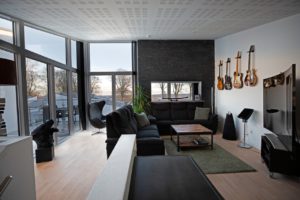Using Timber and Wire Mesh

Welded wire mesh has been a vital component of any construction projects since the dawn of the 18th century. Engineered timber, on the other hand, might be more of a newcomer but its use in the modern construction has been proven to be equally important. In this article, we will talk about the most popular types and applications of engineered timber and welded wire mesh.
Engineered Timber
There are different types of engineered wood for lumber services. Engineered timber is a man-made wooden material that’s helpful in constructions. They are also called composite or derivative wood products. These engineered timber frames are held with adhesives, serrated nails, or screws. Here are some features of the engineered timber.
Engineered Wooden Trusses
It’s easy to find public spaces with residential and commercial structures with roof trusses of engineered timber. Instead of using steel, wooden roof trusses are cost-effective and lighter than metals. Also, floor trusses can create multi-level structural frames that are easy for electricians, plumbers, and AC contractors to work.
Laminated Veneer Lumber (LVL)
Laminated Veneer Lumber (LVL) is a type of engineered timber panel that’s structurally similar to concrete, but have lighter layers. The built-in layers are thin sheets of wood that are held with adhesives. Usually, LVLs are used as beams, floorboards, rafters, rim boards, and columns. As part of the structural composite lumber class of manipulated timber products, LVL can extend longer than natural beams. Other structural applications of laminated veneer lumber products are sawn lumber headers and studs. In public spaces with structural construction sites, LVL panels can withstand heavy loads and retain dimensional stability.
I-Joists
I-joists have structural stability, and strength. This type of wooden structure construction will not split or bend under pressure. Unlike other types of lumber, I-joists have designs of different shapes and are tough while holding heavy loads. Usually, builders prefer engineered wood products (EWPs) like I-joists because they are environmentally friendly, and cost less than traditional lumbers. The invention of EWPs was intended to make construction projects especially the bigger ones such as the ones done for conference venues in Melbourne more cost-effective while improving the strength of structures. Roof trusses with I-Joists frame have triangular patterns that ensure seamless transfer of loads to reaction points. Additionally, floor trusses that are made from I-Joists frames are shorter and cheaper than long 2x12s traditional floor joists.
Cross-Laminated Timber (CLT)
The CNC-machined Cross-Laminated Timber (CLT) goes through the production process that involves 3D modeling software. This type of engineered timber consists of multi-layered panels. Unlike other lumber products, the CLT is rigid and strong. Usually, their end-to-end joints are fitted and screwed together with panels and steel connectors. During shipping, merchants protect the Cross-Laminated Timber (CLT) panels by wrapping them with recyclable plastic. This packaging technique is a safety measure that reduces the risks of marring, water staining, scratching, and sun damage. When CLTs are used as floor, wall or roof panels during construction, they make a quick and efficient installation.
AC Plywood
It’s ideal to use lightweight wooden boards for floor and ceiling structural construction. However, the AC plywood offers aesthetic functions than structural stability. The AC plywood for partitioning public spaces can also serve as wall sheathing materials. A major drawback with AC Plywood is its cost. As one of the most expensive types of engineered wood products (EWPs), AC plywood is an excellent option for big-budget public structures such as the Docklands stadium in Melbourne.
CDX Plywood
As an alternative preference to AC plywood, CDX plywood shares similar features with the former. The CDX plywood is a type of engineered wood product (EWP) with aesthetic features, and it’s suitable for constructing ceilings. These types of plywood add glamour to completed public structures.
Oriented Strand Board (OSB)
As a cheaper alternative to plywood, the Oriented Strand Board (OSB) resists splitting and shrinking. The Oriented Strand Board (OSB) is a type of engineered timber that’s made from strands and fibers. Both wooden particles are held with adhesives, and hot wax and adhesive. This type of large boards is used for wall sheathing and ceilings.
Welded Mesh Products
Welded mesh is a type of wire fabrics that have been a grid of prefabricated arrangements. Each of the strands has been electrically fused as cross wires with horizontal spacing and intersections. Here are common types of welded wire mesh, and their applications.
TYPES
Generally, there are two types of welded wire mesh; welded wire mesh sheets (panels), and welded wire mesh rolls.
Welded Wire Mesh Sheets
Machine-fabricated welded wire mesh sheets have a flat surface and rigid structures. Generally, they are used for construction, agriculture, transportation, landscaping, and gabions. Other uses include Infill panels, fencing, caging, and enclosures. Manufacturers coat these sheets with PVC materials during their fabrication. Also, stainless steel and galvanized iron are used in making superior quality welded mesh sheets. Usually, welded wire mesh sheets are packed by pallet because of their weight.

Welded Wire Mesh Rolls
Usually, welded wire mesh rolls are made from galvanized or black iron materials. Other materials that can be used to produce welded wire mesh rolls are plastic and stainless steel. They are used as external wall insulation, and as a decorative mesh. As high-quality wire, their fabrication involves precise, automated mechanical welding. Also, wire mesh rolls are used for construction, decoration, crack prevention network, window and safety guards.
Galvanization Process
Galvanization is a process of coating steel with protective zinc to prevent rusting. During the manufacturing of wire mesh, carbon or plain steel materials are kept inside a galvanizing tank. Depending on their specification, woven or welded wire mesh can be designed with various levels of corrosion resistance. However, after a period of using galvanized wire mesh products, they show signs of corrosion at their joint or intersection.
Welded wire mesh products for decorative construction have multiple applications. Generally, they serve as ceiling architectural mesh, wall hanging net, color building mesh, and greenhouse seedbed net. However, welded mesh products for building construction are either electro-galvanized or hot-galvanized. In the countryside that is prone to earthquake and environmental disasters, the brick mesh is used to fortify walls during construction.
Specifications of Welded Wire Mesh Products
| Wire diameter (mm) | Spacing (mm) | Horizontal Spacing (mm) | Length (m) | Width (m) | |||
| 10 | 100 to 500 | 30 to 300 | 1 to 8 | 0.5 to 3 | |||
| 9 | 100 to 500 | 30 to 300 | 1 to 8 | 0.5 to 3 | |||
| 8 | 100 to 500 | 30 to 300 | 1 to 8 | 0.5 to 3 | |||
| 7 | 50 to 200 | 20 to 300 | 1 to 8 | 0.5 to 3 | |||
| 6 | 50 to 200 | 20 to 200 | 1 to 8 | 0.5 to 3 | |||
| 5 | 50 to 200 | 10 to 200 | 1 to 8 | 0.5 to 3 | |||
| 4 | 30 to 200 | 10 to 200 | 1 to 8 | 0.5 to 3 | |||
| 2 to 4 | 25 to 100 | 10 to 100 | 1 to 6 | 0.5 to 3 | |||
| 1 | 33 | 15 to 80 | 2.2 | 28 | |||
APPLICATIONS
There are combinations of diameter wires and opening sizes for woven or welded galvanized steel mesh panels. When they are designed for industrial applications, factory works need them for separation or filtration process. At home, people use welded wire mesh products from various purposes. Generally, the mesh is used as window guards, stairwell panel guards, RFI shielding, fireplace screen, and gutter guards. In recent years, commercial applications of wire mesh products have been seen in insect screening, animal fencing, architectural designs, and artworks.
Usually, the construction industry consumes tons of welded wire mesh annually. The blue-spray architectural mesh is a type of galvanized building construction mesh that’s used to enhance the structure of walls. There are other types like the white-spray, yellow and green plastic building construction mesh. Regardless of their fabrication process, plastic or spray protective films are used to minimize corrosion. Since wire mesh surface might be exposed to weather, the spray technology is used to apply different color shades on them.
Welded wire mesh doesn’t often have high corrosion resistance. They might appear strong for some years but degrade in thickness and quality because of corrosion. However, their tensile quality remains intact when they are used for on-site pavement construction.
Take a look at one of the applications of wire mesh in a construction.









